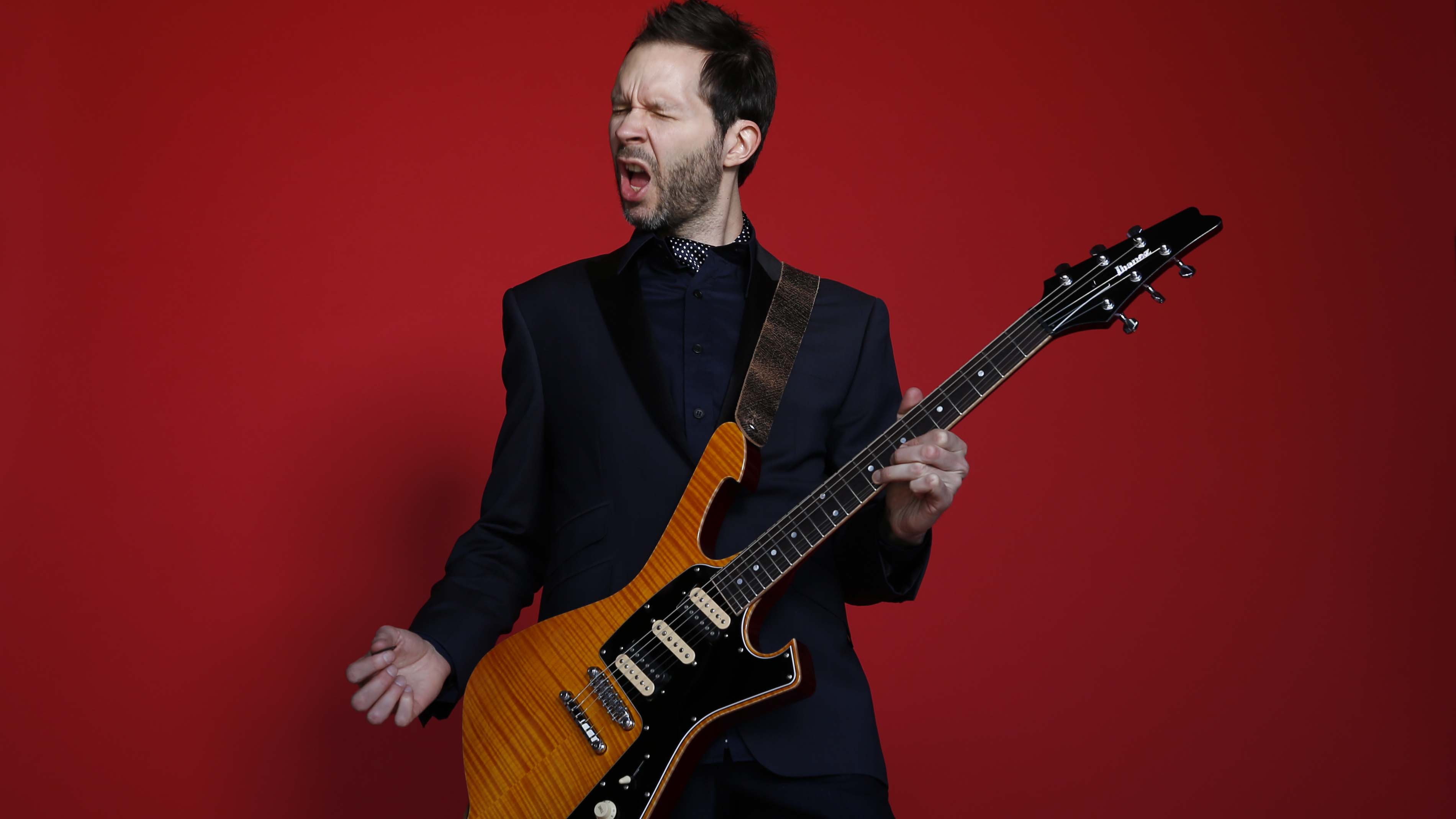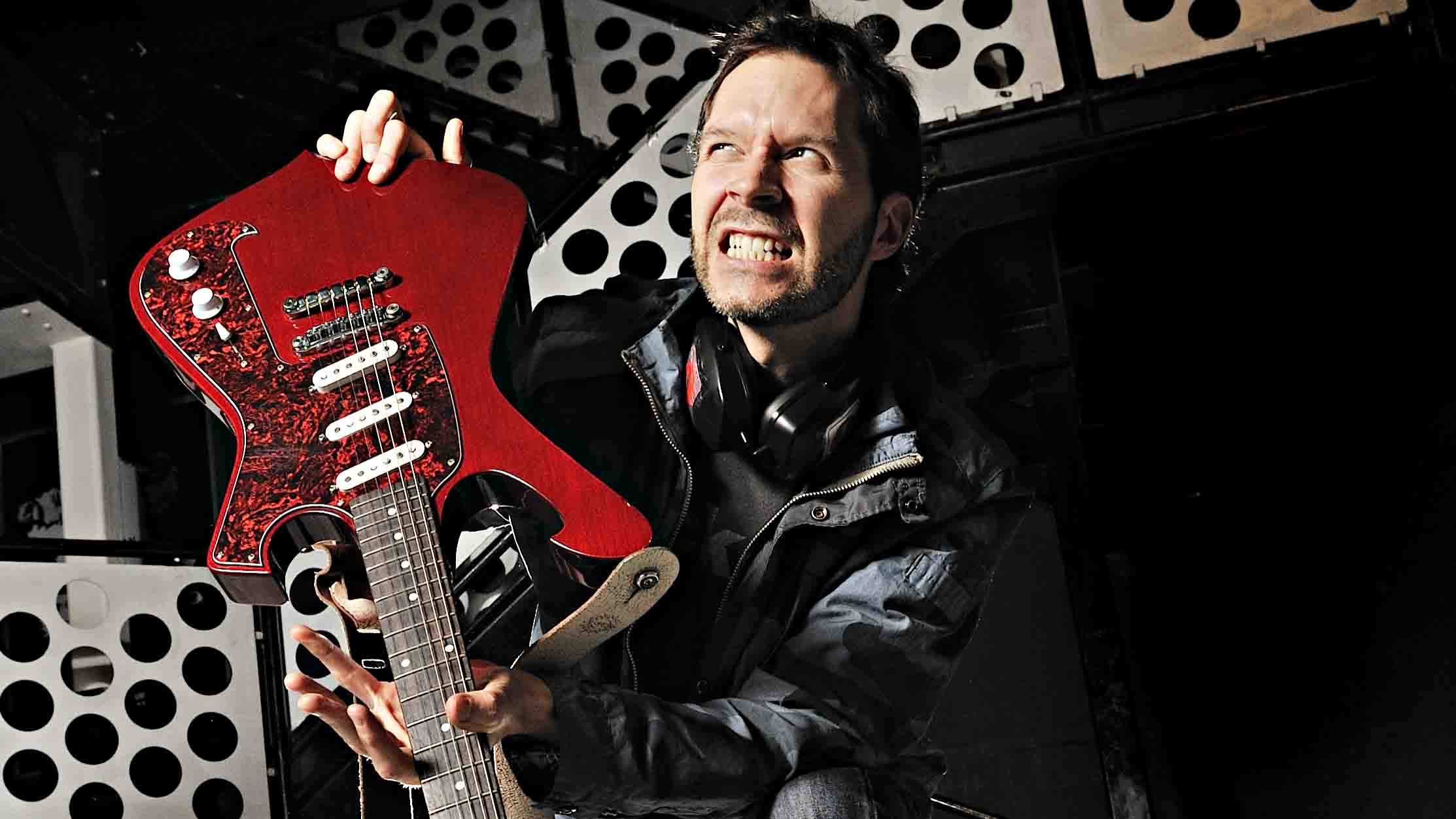Paul Gilbert's top 5 tips for guitarists
"Don't play like your cat; play like a human!"

Introduction: I Can Destroy
Few guitarists walking this Earth can claim to have terrified their fellow gunslingers anywhere near as much as Paul Gilbert, whose blistering speed, technique and phrasing has made him one of the master architects of the '80s shred scene.
His work through Racer X, Mr. Big and as a solo musician has also showcased much beyond that surface-level need for speed, his command of blues reigning ever-distinguishable and growing increasingly more pronounced into his career.
This year’s album I Can Destroy sees the American musician rise towards new challenges, as well as rustle through a few favourites of old…
Whenever I use that drill to play guitar, it puts a smile on everyone’s faces!
“You know, I always forgot I had that drill!” laughs Paul, calling from his guitar studio at home. “Whenever I use that thing to play guitar, it puts a smile on everyone’s faces! It’s almost like if Angus forgot his short pants.
“The drill is part of my 80s identity, so I brought it to the studio not knowing if I would use it. I was just waiting for the right opportunity, which was [blues/jazz ballad] One Woman Too Many - a song the band hadn’t even rehearsed. We ended up recording it all so quickly, we ran outta songs!
“So that track got thrown together really quick an hour before our producer got there. I certainly have a lot of experience with metal - it will always be part of my DNA - but it doesn’t lend itself as well to improvisation as blues or jazz does, where you might not even rehearse at all! You gel and map out the chords, relying much more on the fingerprint of the musician in the present moment.”
It would be fair to say Paul Gilbert is probably the only guitarist in the world more renowned for playing with a drill than a slide. Which is exactly why I Can Destroy saw the guitarist attempt something he never had before: picking up the glass to channel his inner Jimmy Page on the swampy blues-rock of Woman Stop.
“Nobody’s heard me experiment with slide yet,” he reveals. “Probably because they’re all failed experiments, ha ha! I remember back in the Mr. Big days, I’d always have practiced one slide solo. And Kevin Elson, the producer who’d worked with Lynyrd Skynyrd and [Journey guitarist] Neal Schon, would look at me and say, ‘Just play the way you do!’
“I felt like now was the right time for it, and found this big glass thing and put it on my third finger - which I didn’t like at all. Then I moved it to my second, just to get the demo done, and within a minute, I was playing the best slide I ever had in my life! My vibrato got better, my intonation got better… I’d just been using the wrong finger all this time. The middle finger is the magic finger for slide now for me!”
And, even for a guitarist as accomplished as Paul Gilbert, working with an open tuning presented some challenges of its own, forcing him to reimagine the fretboard he’s duly devoted decades to deciphering…
“It was a brain challenge, especially with the open G tuning,” he admits. “As soon as you use an open tuning, about 80 per cent of your licks are gone, because they don’t work any more. So that was a humbling experience, but overall it felt like such a good sound.
“I realised that on slide, I don’t have a lot of licks to rely on. So I chose to focus on things only the slide could do, and for the first time it didn’t feel horrible. Try that second finger - it could be magic!”
Here, the legendary axeman shares even more advice, as he gives up his top five tips for guitar…
I Can Destroy is out now via earMUSIC. If you fancy a spot of drill-picking, check out our guide to using a cordless power drill on a guitar.
Don't Miss
Paul Gilbert: I wrote my best guitar solo on a kazoo
Paul Gilbert: the 10 records that changed my life

1. Rule of thumb
“I’m someone who grew up with '70s rock like Led Zeppelin, and in order to play that, you needed two incredibly important tools. One is thick calluses, which you can only get from bending strings up and down. That’s a physical tool and you need that on all fingers.
“Also, the thumb should hang off the neck [ie, over the fretboard - Ed] almost all the time to give you something to pull against. Take advantage of the fact you’re a human being rather than a chimpanzee or an animal that can’t grip things. Don’t play like your cat; play like a human!
Take advantage of the fact you’re a human being rather than a chimpanzee or an animal that can’t grip things
“Look at Jimi Hendrix: his hands were more on top of the neck than underneath. Not only does that give you strong bending and vibrato, it also helps you mute the strings. If you watch footage of Paul McCartney playing that D chord on acoustic in We Can Work It Out, you see his thumb hanging way off the neck to mute that E string. He might not be regarded as a virtuoso player, but don’t think about being a virtuoso unless you can play a D chord right! So much depends on the thumb.
“The reason I emphasise this is that I see a lot of people playing classical position when I’m teaching, with their thumb really low. For other styles of music that isn’t as applicable. Metal guitar is supposed to be this powerful, aggressive thing and I see guys with this dainty little technique made of tiny little motions - which, of course, you need to play fast - but I personally love hitting it hard, having strength and power. The exceptions are really athletic stretches or barre chords. The thumb and calluses play a big part of that!”

2. Program your foot
“I see people who are able to ignore the metronome. It’s on, but it doesn’t have a built-in alarm to say, ‘Dude! You’re drifting!’ If you take metronomic responsibility with your foot and make that your centre point, it can come from within.
“If you want to have good relationships with other musicians and no arguments with your drummer, you need to have an inner sense of time. You can’t depend on others to fix you, so developing the ability to keep time with your foot not only improves your meter, it also improves your groove - how you emphasise every beat. If you stomp on 2 and 4, it feels more rock - that’s where the snare hits.
“There are so many players I’ve seen that couldn’t stomp at all. It’s a skill, like when drummers get independence between their hands. If you look at old Muddy Waters footage and other guys like that - those that became the core of rock guitar - you’ll see them keeping their own time. Then there’s Angus, who’s a full-on body stomper!”

3. Look at intervals like colours
“So, I guess we should probably now do something that involves playing guitar. Lately, I’ve been improvising and have found it’s really important to know the language of intervals, which is the relationship between each note.
“If you look at the pentatonic scale, it’s important to know how each one relates to your key centre. Find out where your thirds are all over the neck; don’t think of them as ‘C’ or whatever - think of them as your minor thirds.
It’s a bad habit for guitarists to simply just play scales in order
“Those become your colours, and soon you’ll find there’s your blue, there’s your yellow and so on. Improvising is so important for creating melodies. It’s a bad habit for guitarists to simply just play scales in order, and I think it’s much cooler to hear melodies with wider intervals.
“A good example of this would be The Beatles’ guitar solo on the song Birthday: the first two notes are a fifth apart. I would never have thought of that in a million years - guitar players naturally would go to the scale in order. It almost sounds like Ray Charles once you start connecting all the dots, so I’d say knowing your intervals is incredibly important.”

4. Silence followed by a deafening roar
“The next thing I have to point out is dynamics. Practising scales can destroy your dynamics, because you try to make everything the same length and volume. You become this note-machine, stamping them off the same size and texture.
“But when you put the boat in the water and try to make it float - my metaphor for playing with other musicians - dynamics play such a huge part in musicality. Volume, speed and length can fill up space differently, so why not combine it? It will be 1,000 times more expressive than doing one.
Beginner guitar players are so caught up in making everything the same, they actually cause damage to their musicality
“Technique can come from hammer-ons and pull-offs, or muting for more staccato sounds - it’s amazing how rare this is in beginner guitar players. They’re so caught up in making everything the same, they actually cause damage to their musicality. Try to make everything not the same! You have to get your pull-offs really strong to do that.
“Of course you have dynamics of volume, which I got from playing shuffles - not all the strokes are the same, some loud and some soft. Metal guys don’t tend to swing, but we can all benefit from learning it through a technique standpoint. One thing I often do is play two notes: one muted and soft, the other ringing out and more sustained. Quiet, loud, quiet, loud and so on.”

5. Say no to bad vibrato
“Vibrato has to be in tune and have some sort of rhythmic intention to it. Listen to those early Ace Frehley solos: you can almost count the song to his vibrato - each bend is perfectly in tune and perfectly in time.
“I’d say the trick is to have your own vibrato heroes and learn from them! Listen to Brian May, Robin Trower, Eddie Van Halen, Yngwie, Schenker, Blackmore, Hendrix… any of those guys, and plant that sound in your ears. What is it that makes them sound unique? Hold your guitar and just make that thing sing. Most importantly of all, make yourself love it.”
Don't Miss
Paul Gilbert: I wrote my best guitar solo on a kazoo
Paul Gilbert: the 10 records that changed my life
Amit has been writing for titles like Total Guitar, MusicRadar and Guitar World for over a decade and counts Richie Kotzen, Guthrie Govan and Jeff Beck among his primary influences. He's interviewed everyone from Ozzy Osbourne and Lemmy to Slash and Jimmy Page, and once even traded solos with a member of Slayer on a track released internationally. As a session guitarist, he's played alongside members of Judas Priest and Uriah Heep in London ensemble Metalworks, as well as handling lead guitars for legends like Glen Matlock (Sex Pistols, The Faces) and Stu Hamm (Steve Vai, Joe Satriani, G3).
